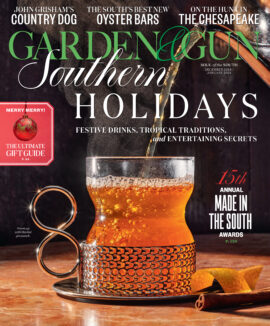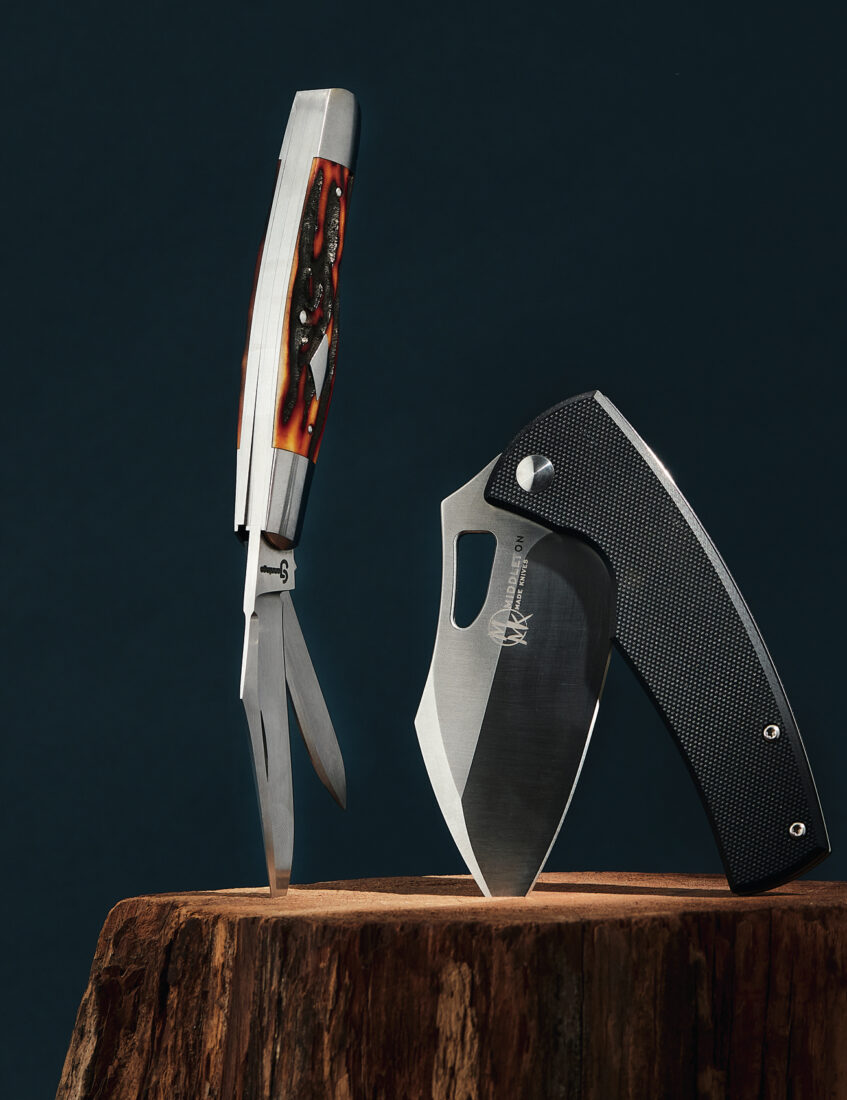There’s so much that can go wrong. Building a folding knife involves the fabrication of multiple moving parts, at least one hinge, a handle composed of separately worked materials, and more than a yeoman’s grasp of geometry and materials science. That’s why so few give it a go. To achieve the highest professional certification in knife making—that of Master Bladesmith, conferred by the American Bladesmith Society—you needn’t have ever built a single pocketknife. When it comes to folders, says the lauded South Carolina knife maker Quintin Middleton, “a mistake of one-thousandth of an inch could mean I have to start completely over.”
But when everything goes right, the result is an exquisite tool. Two modern craftsmen in the South have approached the conundrum of handcrafting folding knives in very different ways. One hearkens back to the classic designs of the era of mule-drawn farm carts. The other is pushing the design envelope with folding culinary knives that are unlike anything else on the market.

Long before he made his first folding knife, Middleton, a knife maker in St. Stephen, South Carolina, had made a name for himself as a culinary bladesmith. A former industrial mechanic at a Mercedes-Benz plant north of Charleston, he began shopping his chef’s knives around Charleston’s commercial kitchens in late 2009. Collaborating with Craig Deihl, then executive chef of the city’s renowned Cypress, and his chef de cuisine, Bob Cook, helped Middleton home in on culinary knife designs that sold so well he went full-time as a knife maker in early 2011.
Soon, Middleton noticed that chefs were leaving their knife rolls behind when they traveled to cooking demonstrations and public events. “Or they wouldn’t have the right knife, and ask to borrow one from me,” he recalls. “I thought, why couldn’t I make something they could just put in their pocket and never be without?”
His first folding chef’s knife came out in 2013, and would eventually morph into the ONA. With a five-inch blade and a sleek handle frame of smooth titanium, the liner lock knife “was built like a Ferrari,” Middleton says. His most recent creation, the brand-new Mini ONA, takes a more egalitarian approach. Middleton switched out the full titanium handles for a titanium frame with textured G10 for a sure grip, and added a belt clip. The Mini ONA is a knife designed as much for the hunt camp as the home kitchen. It’s an F-150 to the ONA’s Ferrari.
“I’ve seen so-called folding chef’s knives that were really a pocketknife trying to be a chef’s knife,” he says. “I did the opposite.” The ONA and the Mini ONA are essentially folding santoku knives, with two-inch-wide sheepsfoot blades of S35VN steel.

While Middleton’s folding chef’s knives are decidedly modern, the folding knives that come out of Grayson Jennings’s Winston-Salem, North Carolina, shop are modern expressions of famed nonlocking slip-joint folders such as barlow and trapper knives. Brands such as Case and Old Timer have produced those by the millions, but Jennings builds them with an artful approach impossible to duplicate in a factory. As a teenager, he was a Boy Scout and a hunter and angler, who “caught a wild hair one day,” he explains, and started hacking on a piece of steel with an angle grinder. The twenty-five-year-old now makes traditional folding knives nearly full-time.
To put a modern spin on his designs, Jennings uses the most advanced steels for his blades, like the new ultratough MagnaCut steel. And while he isn’t averse to dolling up knives with decorative spacers and fine file work on back springs, most of his pocketknives are adorned with traditional handle scales of sambar stag, jigged bone, and old Micartas.
At his shop, Jennings cuts out every knife blade, bolster, and back spring. He does all the heat treating, grinding, hand finishing, and sharpening. “I touch every knife every step of the way,” he says. And as with Middleton, such a hands-on, perfectionist approach is both a blessing and a curse. “The folders require a fine line between mechanical perfection and what you seek to express as functional art. I’ve thrown away more knives than I’ve actually finished.” And while the appeal stems from heritage and history, there’s also old-school street cred.
“You pull out some ridiculous bowie knife at deer camp and everybody rolls their eyes,” Jennings says. “But you pull out that little barlow knife and it’s like, Okay, this guy must know what he’s doing.”








